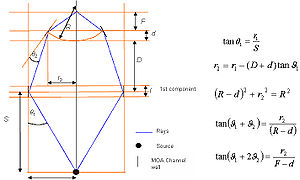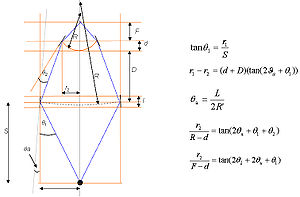
Microstructured optical arrays
Encyclopedia
Microstructured optical arrays (MOAs) are instruments for focusing x-ray
s. MOAs utilise total external reflection
at grazing incidence from an array of small channels in order to bring x-rays to a common focus
. This method of focusing means that MOAs exhibit low absorption
. MOAs are used in applications which require x-ray focal spots in the order of few micrometers or below, such as radiobiology
of individual cells. Current MOA-based focusing optics designs have two consecutive array components in order to reduce comatic aberration
.
 MOAs are achromatic (which means the focal properties do not change for radiation of different wavelengths) as they utilize grazing incidence reflection. This means that they are able to focus chromatic radiation to a common point unlike zone plate
MOAs are achromatic (which means the focal properties do not change for radiation of different wavelengths) as they utilize grazing incidence reflection. This means that they are able to focus chromatic radiation to a common point unlike zone plate
s. MOAs are also adjustable as the optic can be compressed in order to alter the focal properties such as focal length
. Focal length can be calculated for the system in fig. 1 using the geometry shown in fig. 2 where it can be seen that changing the gap between the components (d+D in the figure) or the radius of curvature (R) will have a large effect on the focal length.
 MOAs have been used in configurations shown in figs. 1 & 3 whereby one or both components can be adjusted. This has varying effects on the focal properties, in general it has been found that smaller focal spot sizes are apparent when MOAs are used as shown in fig. 1 with only the second component adjusted.
MOAs have been used in configurations shown in figs. 1 & 3 whereby one or both components can be adjusted. This has varying effects on the focal properties, in general it has been found that smaller focal spot sizes are apparent when MOAs are used as shown in fig. 1 with only the second component adjusted.
 The focal length of this system can be calculated using the geometry shown below:
The focal length of this system can be calculated using the geometry shown below:

and created via the Bosch process, an example of Deep reactive ion etching
and not to be confused with the Haber-Bosch process. In the Bosch process the channels are etched into the silicon
using a plasma (plasma (physics)
) in increments of a few micrometres. In between each etching the silicon is coated with a polymer in order to preserve the integrity of the channel walls.
instrumentation where x-rays are focused onto a biological sample to investigate phenomena such as the bystander effect
.
In order to target a specific cell
the focal spot size of the system must be around 10 micrometers whereas in order to target specific areas of a cell such as the cytoplasm
or the cell nucleus
it should be no more than a few micrometers. Currently only MOAs in the configuration shown in fig. 1 are thought to be able to achieve this.
MOAs provide a good alternative to zone plates in microprobe use due to the adjustable focal properties (making cell alignment easier) and ability to provide focusing of chromatic radiation to a single point. This is particularly useful when considering the finding that different effects can be observed using radiation of different wavelengths.
X-ray optics
X-ray optics is the branch of optics which manipulates X-rays instead of visible light. While lenses for visible light are made of transparent materials that can have a refractive index substantially larger than 1, for X-rays the index of refraction is slightly smaller than unity. The principal...
s. MOAs utilise total external reflection
Total external reflection
Total external reflection is an optical phenomenon where electromagnetic radiation can, at certain angles, be totally reflected from an interface between two media of different indices of refraction...
at grazing incidence from an array of small channels in order to bring x-rays to a common focus
Focus (optics)
In geometrical optics, a focus, also called an image point, is the point where light rays originating from a point on the object converge. Although the focus is conceptually a point, physically the focus has a spatial extent, called the blur circle. This non-ideal focusing may be caused by...
. This method of focusing means that MOAs exhibit low absorption
Absorption (electromagnetic radiation)
In physics, absorption of electromagnetic radiation is the way by which the energy of a photon is taken up by matter, typically the electrons of an atom. Thus, the electromagnetic energy is transformed to other forms of energy for example, to heat. The absorption of light during wave propagation is...
. MOAs are used in applications which require x-ray focal spots in the order of few micrometers or below, such as radiobiology
Radiobiology
Radiobiology , as a field of clinical and basic medical sciences, originated from Leopold Freund's 1896 demonstration of the therapeutic treatment of a hairy mole using a new type of electromagnetic radiation called x-rays, which was discovered 1 year previously by the German physicist, Wilhelm...
of individual cells. Current MOA-based focusing optics designs have two consecutive array components in order to reduce comatic aberration
Coma (optics)
In optics , the coma in an optical system refers to aberration inherent to certain optical designs or due to imperfection in the lens or other components which results in off-axis point sources such as stars appearing distorted, appearing to have a tail like a comet...
.
Properties

Zone plate
A zone plate is a device used to focus light or other things exhibiting wave character. Unlike lenses or curved mirrors however, zone plates use diffraction instead of refraction or reflection. Based on analysis by Augustin-Jean Fresnel, they are sometimes called Fresnel zone plates in his honor...
s. MOAs are also adjustable as the optic can be compressed in order to alter the focal properties such as focal length
Focal length
The focal length of an optical system is a measure of how strongly the system converges or diverges light. For an optical system in air, it is the distance over which initially collimated rays are brought to a focus...
. Focal length can be calculated for the system in fig. 1 using the geometry shown in fig. 2 where it can be seen that changing the gap between the components (d+D in the figure) or the radius of curvature (R) will have a large effect on the focal length.



Manufacturing
Current microstructured optical arrays are composed of siliconSilicon
Silicon is a chemical element with the symbol Si and atomic number 14. A tetravalent metalloid, it is less reactive than its chemical analog carbon, the nonmetal directly above it in the periodic table, but more reactive than germanium, the metalloid directly below it in the table...
and created via the Bosch process, an example of Deep reactive ion etching
Deep reactive ion etching
Deep reactive-ion etching is a highly anisotropic etch process used to create deep penetration, steep-sided holes and trenches in wafers/substrates, typically with high aspect ratios...
and not to be confused with the Haber-Bosch process. In the Bosch process the channels are etched into the silicon
Silicon
Silicon is a chemical element with the symbol Si and atomic number 14. A tetravalent metalloid, it is less reactive than its chemical analog carbon, the nonmetal directly above it in the periodic table, but more reactive than germanium, the metalloid directly below it in the table...
using a plasma (plasma (physics)
Plasma (physics)
In physics and chemistry, plasma is a state of matter similar to gas in which a certain portion of the particles are ionized. Heating a gas may ionize its molecules or atoms , thus turning it into a plasma, which contains charged particles: positive ions and negative electrons or ions...
) in increments of a few micrometres. In between each etching the silicon is coated with a polymer in order to preserve the integrity of the channel walls.
Applications
The focal spot size is important in x-ray microprobeMicroprobe
A microprobe is an instrument that applies a stable and well-focused beam of charged particles to a sample.-Types:When the primary beam consists of accelerated electrons, the probe is termed an electron microprobe, when the primary beam consists of accelerated ions, the term Ion Microprobe is used...
instrumentation where x-rays are focused onto a biological sample to investigate phenomena such as the bystander effect
Bystander effect
The bystander effect or Genovese syndrome is a social psychological phenomenon that refers to cases where individuals do not offer any means of help in an emergency situation to the victim when other people are present...
.
In order to target a specific cell
Cell (biology)
The cell is the basic structural and functional unit of all known living organisms. It is the smallest unit of life that is classified as a living thing, and is often called the building block of life. The Alberts text discusses how the "cellular building blocks" move to shape developing embryos....
the focal spot size of the system must be around 10 micrometers whereas in order to target specific areas of a cell such as the cytoplasm
Cytoplasm
The cytoplasm is a small gel-like substance residing between the cell membrane holding all the cell's internal sub-structures , except for the nucleus. All the contents of the cells of prokaryote organisms are contained within the cytoplasm...
or the cell nucleus
Cell nucleus
In cell biology, the nucleus is a membrane-enclosed organelle found in eukaryotic cells. It contains most of the cell's genetic material, organized as multiple long linear DNA molecules in complex with a large variety of proteins, such as histones, to form chromosomes. The genes within these...
it should be no more than a few micrometers. Currently only MOAs in the configuration shown in fig. 1 are thought to be able to achieve this.
MOAs provide a good alternative to zone plates in microprobe use due to the adjustable focal properties (making cell alignment easier) and ability to provide focusing of chromatic radiation to a single point. This is particularly useful when considering the finding that different effects can be observed using radiation of different wavelengths.

